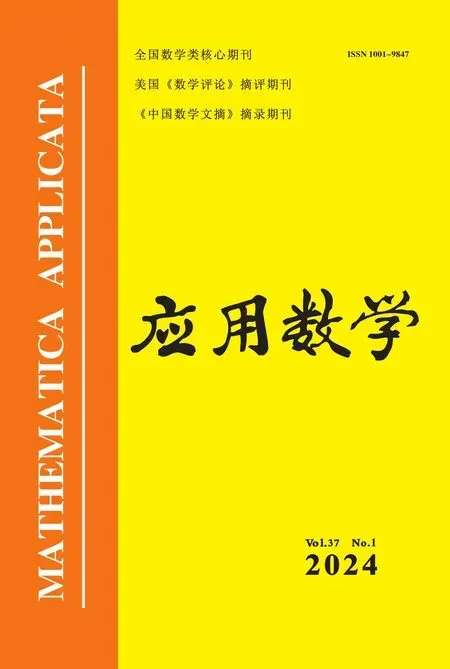Trudinger-Moser Inequalities with Logarithmic Weights of Negative Power
ZHU Maochun(朱茂春),MA Pan(马盼)
(School of Mathematical Sciences, Jiangsu University, Zhenjiang 212013, China )
Abstract: In this work,we consider the Trudinger-Moser inequality with logarithmic weights of negative power.By establishing a Radial lemma and the Lecband’s functional inequality,we shows that the Trudinger-Moser inequalities with logarithmic weights of positive power obtained by Calanchi and Ruf (2015) still hold when the power is negative.
Key words: Radial;Negative Power;Logarithmic weight;Trudinger-Moser inequality
1.Introduction
whereωN-1is the surface area of the unit ball in RN.
There have been many generalizations related to the Trudinger-Moser inequality: extensions of Moser’s inequality to unbounded domains[5-8],extensions of the Trudinger-Moser inequality to higher order Sobolev spaces[9-13],Trudinger-Moser type inequality in Lorentz-Sobolev space[14-16],and Trudinger-Moser inequalities on Heisenberg groups[17-20].
An interesting question is whether the Trudinger-Moser inequalities with logarithmic weights still hold when the powerβ(N-1) is negative.In this work,we will give a positive answer for this question.
where cl stays for the closure of smooth radial functions with compact support inBunder the normand
Our main result reads as following.
2.Trudinger-Moser Inequalities with Logarithmic Weights of Negative Power
In order to study the Trudinger-Moser inequalities with logarithmic weights of negative power,we first establish a Radial lemma which is crucial in the proof of Theorem 1.1.
Lemma 2.1(Radial lemma) Assumeuis radially symmetric in(B).Then
ProofLetu(x)=v(|x|).Then,by H¨older’s inequality
Similarly,we can obtain (2.2).
Definition 2.1A continuous functionρ: [0,∞)→[0,∞) is called aC∗-function if there is a constantCρ>0 such that for every 0
for alll ≥Dand 0 Definition 2.2AC∗-functionM: [0,∞)→[0,∞) is called aC∗-convex function ifMis convex,and the function definedρby the differential equationρ(M(t))=M′(t) is aC∗-function. andαN,βis the bestconstant given inTheorem1.1(b). Hence,for alls ≥S,by H¨older’s inequality This means that there existssuch that We omit the details. For the critical case,we need Lemma 2.2. LetΦ ≥0 be a nonincreasing function on [0,∞),andM(t) be aC∗-convex function.Then there exists a constantC>0 such that whereψ(s)∈C1([0,∞)) is given by (2.3).By directly calculating,we have Furthermore,with this choice ofφone has He nce,with these suitable choices,using Leckband’s inequality we haveass ≥Mδenough large. With the direct calculation,we have Hence,from Lemma 2.1 we obtain The proof of Theorem 1.1(b) is completely finished.

